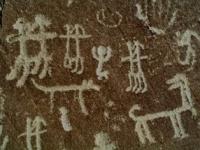You are here
Petroglyphs of Kirbukan.

Petroglyphs Walking Tour in Uzbkestan.
“An ancient burial site will always hold clues as to who the people were, and to who we are”
Anthony T. Hincks.
Tour to Petroglyphs Kurbikan in Uzbekistan.
Petroglyphs of Kirbukan are located in the Navoi region. A total of 576 images were found along the right bank of a dry gorge. They can be divided into two parts: the main complex and individual concentrations of images located in different parts of the gorge.
The main complex, compact, looks like an individual group. The repertoire of Kyrbukan petroglyphs is diverse: anthropomorphs, animals, birds, and solar signs as well as many Arabic and modern inscriptions. Stratigraphic analysis enabled A.V. Oskin to determine the sequence of creation of images on each rock.
The findings of his survey helped identify several reference periods that were used to date the petroglyphs in the main complex. The first period dates to the Bronze Age (IInd to beginning of 1st millennium BC) with “skeletal” petroglyphs, contours, and outlined anthropomorphs with animal and bird masks and tails.
The second stage dates to the Early Iron Age (Ist millennium BC), with felines with prominent napes, spiral tails and a specific predator attitude. The third period may date to the threshold of the modern era. Modern engravings stand out among ancient petroglyphs.
The site, registered with the government, receives protection from the local authorities in the Navoi Region of the Republic of Uzbekistan. However, its boundaries and protection zones have not yet been defined and physical protection is non-existent.
In recent years, some tourist companies have taken the initiative to protect the Kyrbukan and Bohali petroglyphs and to use them for ecotourism. The sites, located far from the central districts and main traffic arteries, are thus considered as hard-to-reach areas.
However, there are plenty of cattle farms and the local population continues to make graffiti on the rocks and damage ancient petroglyphs. Damage is also due to natural causes: rock surface erosion and moss and lichen growth.
Authority:
Muhiddin Khujanazarov.
Photos by
Alexander Petrov.







